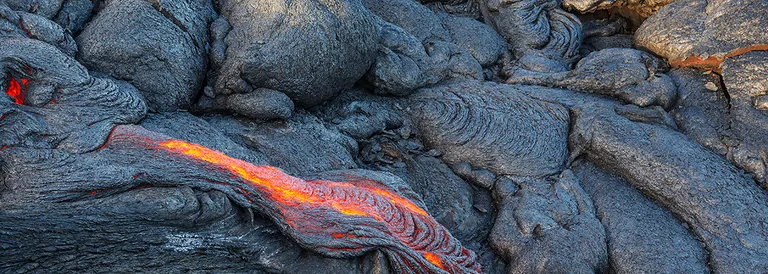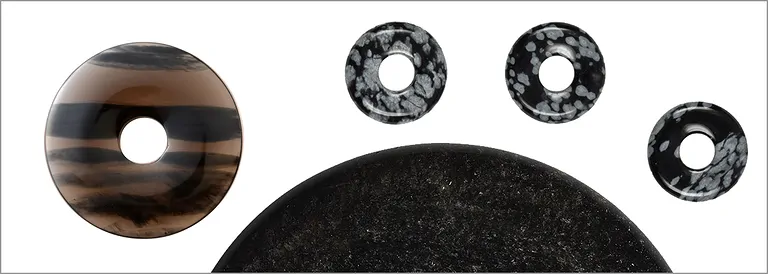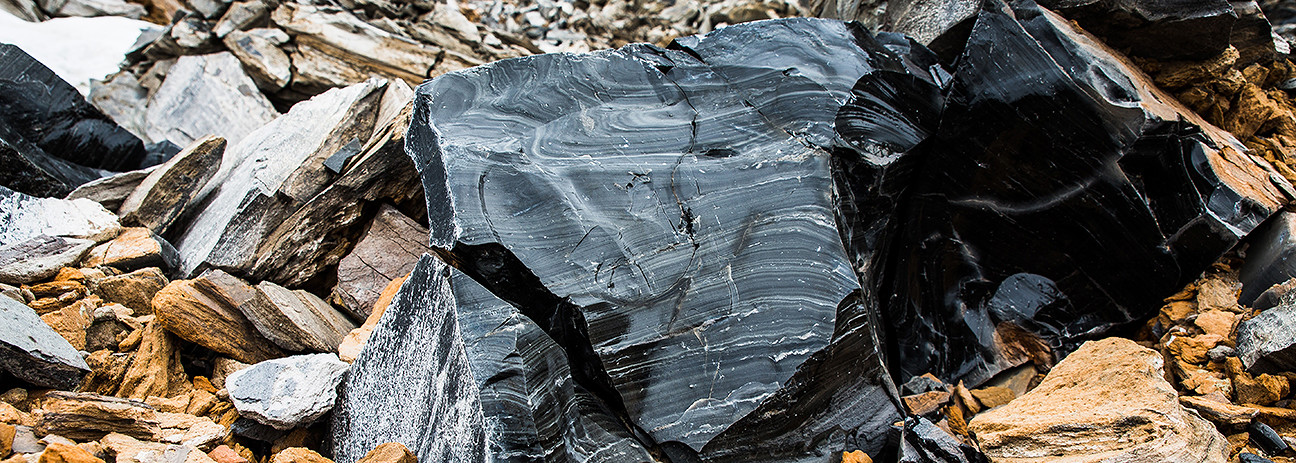
Obsidian - Stone of the Month January 2026
January lies quietly and peacefully over the landscape, but there is a barely tangible sense of optimism in the air. Nature seems to have fallen into a peaceful hibernation, but it is precisely in this silence that an unexpected power lies. The days are slowly getting longer, and with every ray of sunshine that breaks through the gray winter blanket, our anticipation of what may come grows.
Obsidian helps us to remove blockages and obstacles. Just as obsidian rose from the depths of the earth to the earth's surface during its formation, overcoming many obstacles along the way, the stone can help us to leave the outdated and superfluous behind. With a new perspective on things, we can start the new year with renewed energy.
Obsidian represents two important aspects of life:
The dark stone directs the view also to the dark sides of life. Obsidian leads us to our hidden idiosyncrasies and then supports in the reconciliation with the shadow sides of our being. Thus in tune with ourselves, we can take new angles and develop perspectives for the second half of the year. With rediscovered abilities, we can swingingly tackle life.
The second theme of the Obsidian is the resolution of (old) blockages and obstacles. With the momentum of summer and the power of obsidian, obstacles can be cleared out of the way - just as obsidian came to the surface from the depths of the earth when it was formed and overcame many an obstacle in the process, so the stone can help us to leave behind what is outdated and superfluous. Ingrained behaviors and thought patterns can be overcome.
For retailer: rough stones, smooth stones, bracelet, stringed beads and much more obsidian items

Formation of Obsidian
Obsidian is formed when molten material from deep, hot layers of the earth comes to the surface through a volcanic eruption, cools and solidifies. Due to the rapid cooling of the lava, no separation of different ingredients takes place during the formation of Obsidian. Depending on the place of discovery and the conditions of formation, the Obsidian has different compositions and is not homogeneous even at one place of discovery. Therefore, the obsidian is also not attributed to the minerals with uniform material composition, but to the rocks.
If the foreign substances are numerous and evenly distributed, one speaks of black obsidian. In contrast to this, the transparent appearing smoke obsidian arises from lava with very few foreign substances.
If many small air bubbles are distributed in the Obsidian, at which the incident light is reflected, it is silk gloss obsidian. Depending on the color expression one speaks of silver luster obsidian or gold luster obsidian. If instead of gas bubbles small water bubbles are contained in the rock, the iridescent Rainbow Obsidian is formed from the lava. The incident light is not only reflected, but also scattered and broken down into its various colors.
When the iron oxide content in the Obsidian is very high, irregular brown spots form in the black mass due to the deposition of this iron oxide. Due to the color of the spots, this rock is then called Mahogany Obsidian. Other spellings and names are mahogany obsidian or mountain mahogany.
Snowflake Obsidian is formed when devitrification, i.e. the slow formation of crystalline structures in the amorphous obsidian mass, produces small gray feldspar aggregates. These remind of snowflakes, clouds or flowers; therefore, flower obsidian and cloud obsidian are further names for this rock.
Midnight lace Obsidian emerges volcanically by the rapid cooling of silica-rich lava flows. By segregation in the flowing lava, fine ore layers form in the transparent Obsidian, causing the lamellar appearance.
Other very rare varieties of obsidian include fire obsidian (red in colour due to thin layers of tiny magnetite crystals; the only known location to date is in Oregon, USA) and Cali glass (rhyolitic volcanic glass; the only location is near Cauca, Colombia).
For retailer: tumbled stones, pendants, jewelry, stringed beads and much more obsidian items

Mineralogical profile of Obsidian
Obsidian is a natural glass. When the word "Glass" is used in mineralogy, it does not mean that an industrially manufactured, transparent object is being described. "Glass" means that the material has no crystal structure.
Chemical formula: rock glass with predominantly SiO2
Mineral class: mixtures of different silicates
Formation: Volcanic, due to rapid cooling of silica-rich magmas, as crust on lava
Color: Black, brown, gray
Gloss: Vitreous luster
Crystal system: amorphous
Moh hardness: 5 to 5.5
Cleavability, fracture: no fissility, large-muscled, sharp-edged fracture
Localities, main supplying countries: USA, Mexico, Italy
Appearance: coarse masses, partly.Partly with white sprinkles, brown spots, rarely with silvery or golden iridescence or variegated, iridescent colors
Rough stones, pendants, jewelry, stringed beads and much more obsidian items at wholesale prices

Origin of the name Obsidian and synonyms
The name probably goes back to the Roman explorer Obsidius, who first brought obsidian from Ethiopia to Rome in ancient times. The first written mention of obsidian was in Pliny the Elder's Natural History "Naturalis historia" as “Lapis Obsidianus.” The ancient Greeks referred to obsidian as “Liparios,” which goes back to its early discovery on the Aeolian Islands (Liparian Islands).
Synonyms for obsidian occasionally found in trade include lava glass, marekanite, and volcanic glass, as well as the misleading glass agate, Icelandic agate, Montana jet, and Tokay lux sapphire. Names for obsidian that are less common today include pitch stone, shadow stone, and black glass. The indigenous peoples of North America referred to obsidian as xaga.
The terms “blue obsidian” or “blue volcanic glass” are misleadingly used to describe synthetically produced material. The product sold under the name “green obsidian” or “St. Helens obsidian” is said to originate from the eruption of Mount St. Helens in the USA. However, no lava flowed during this eruption. The manufacturer's claim that this glass is produced by melting ash from various parts of the volcano is also untrue. Ash from Mount St. Helens melted in the laboratory for testing purposes always produced brown-black glass. “Green obsidian” is nothing more than green-colored glass that has no volcanic components.

Usage of Obsidian
Obsidian is one of the oldest cultural assets of mankind - from the obsidian blade of the Stone Age to ancient amulets to the widely used modern jewelry stone. As early as the Stone Age in Europe, obsidian was used to make blades and sharp-edged tools for scraping hides and skins. In Mexico, obsidian was used to make figurines of deities, and the Aztecs used obdisian to make points for arrows and spears as well as obsidian swords.
As a meditation object, crystal skulls made of obsidian are popular to this day, because the similarity to the human head images, thoughts and impressions can be focused particularly well. Raven Scull ("Raven Scull") made of black Obsidian combine the power of Obdisian with the symbol of the bird skull, which stands for wisdom, intelligence, courage and determination - an ideal combination to help projects and plans to the breakthrough. Also, the shape of the pyramid supports the energy of the stone, in which it bundles and aligns its forces through the aspiring, pointed shape.
Obdisian helps to also recognize and accept their own shadow sides. Blockades can be dissolved, lost believed knowledge and skills become accessible again. The perception of the environment is strengthened, so that old patterns can be traced and dissolved. What was previously unclear and confusing can now be seen through.
In astrology, Obsidian is used to promote clairvoyance and striving for knowledge in Scorpio-born people. In the Native American medicine wheel, it is the totem of the Wapiti moon (Sagittarius).

Obsidian mirror
Mirrors were already made from Obsidian by the ancient Romans; however, these probably did not serve cultic or energetic purposes, but only as mirrors and room decorations. Modern stone medicine discovered the power of the stone in the course of the 20th century. For example, the well-known stone healer Klaus Hüser developed the Obsidian meditation with the "Magic Mirror".
Instructions for meditation with obsidian mirrow
Also in "Game of Thrones" the Obsidian plays an important role under the name Dragonglass (Dragonglass). In the vanished capital Valyria, the Obsidian was called zīrtys perzys ("frozen fire"). Originally, the Children of the Forest made spearheads and daggers from Obsidian, which were used in battle against the White Walkers. Dragonglass even gave its name to Dragon Isle because of the abundant obsidian deposits there. In the eastern part of Essos, dragonglass is also used as jewelry and amulets. Furthermore, dragonglass is considered in Game of Thrones as a means that can cure diseases.